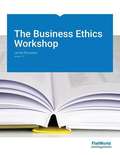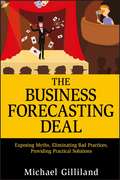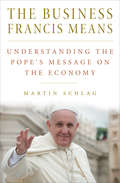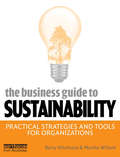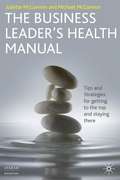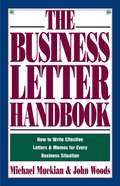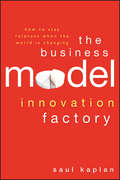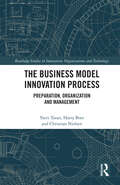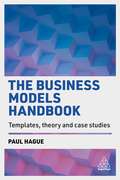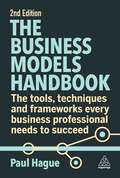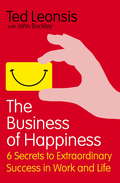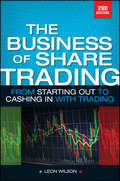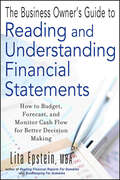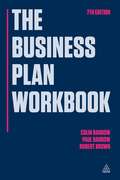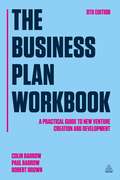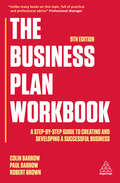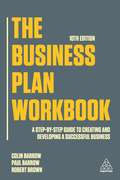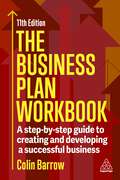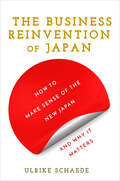- Table View
- List View
The Business Ethics Workshop v 1.0
by James BrusseauOn a good day in the business ethics classroom discussion charges forward; students have read the assigned case study, they're engaged by the conflict and want to work through it. Then, there's a bad day: students didn't bother to do the reading and the hour sags listlessly. The key to going the first way is case studies that students want to read, and The Business Ethics Workshop by James Brusseau provides them with reality and engagement. Reality: No stilted and contrived stories about Steve Smith and Jane Jones. Excerpts from blogs and newspapers bring the weight--and provocation--of the world as it's actually happening to the classroom.
The Business Forecasting Deal
by Michael GillilandPractical-nontechnical-solutions to the problems of business forecasting Written in a nontechnical style, this book provides practical solutions to common business forecasting problems, showing you how to think about business forecasting in the context of uncertainty, randomness and process performance. Addresses the philosophical foundations of forecasting Raises awareness of fundamental issues usually overlooked in pursuit of the perfect forecast Introduces a new way to think about business forecasting, focusing on process efficiency and the elimination of worst practices Provides practical approaches for the non-statistical problems forecasters face Illustrates Forecast Value Added (FVA) Analysis for identifying waste in the forecasting process Couched in the context of uncertainty, randomness, and process performance, this book offers new, innovative ideas for resolving your business forecasting problems.
The Business Francis Means: Understanding the Pope's Message on the Economy
by Martin SchlagAn overview of Pope Francis&’s teachings on money and morality that bridges the gap between political sides. Pope Francis, generally speaking, has thus far chosen to concentrate his papacy on social justice issues, as opposed to doctrinal or liturgical issues. This has led to Francis being hailed as a hero to many on the left, while it has made some conservative supporters of St. John Paul II and Pope Emeritus Benedict XVI disappointed and uncomfortable, even as they love and appreciate his person and gestures of mercy and compassion. Some find his teachings difficult to embrace, especially those concerning business and the economy. Pope Francis has spoken of building bridges as part of what it is to be Christian, but aspects of his message seem to be just constructing walls between the Holy Father and groups of the faithful. The Business Francis Means aims to break through these walls, showing that Pope Francis has something to say to all Christians. His message, taken as a whole, keeps us from dividing the &“seamless garment&” of Christ: he reminds the conservatives of the problems of inequality and poverty, and the liberals that social justice is not enough—the Church is the bride of Christ, not a social institution or an NGO. Martin Schlag summarizes and explains the message of Pope Francis on business and the economy in this compact volume. The Business Francis Means will be of great interest to the Catholic layperson, especially one involved in political or economic life.
The Business Guide to Effective Compliance and Ethics: Why Compliance isn't Working - and How to Fix it
by Andrew Hayward Tony OsbornAcross the world organizations continue to be damaged and brought down by systemic non-compliance or the misdeeds of a few, and newspapers abound with examples of corporate and NGO scandals and crimes. This despite the increasing ethical demands stakeholders are making of business, the exposing power of social media, the proliferating requirements of compliance laws and regulations, and the burgeoning numbers of policies, procedures and compliance officers which have been put in place in response. So what's going on? Why isn't compliance working? The Business Guide to Effective Compliance and Ethics examines how rules-based, tick-box, defensible compliance continues to fail, and lays out a new approach for organizations seeking to flourish and succeed.Written for any organization and businesses large and small, it provides clear, thorough and practical guidance for practitioners and decision-makers. It explains in layman's terms the skills, tools and mindset needed to develop and deliver a best practice compliance and ethics programme - one that meets the requirements made by law, stakeholders and society, and protects your organization from risk of fines, penalties and reputational damage. But this is also a book for all those interested in how to build employee engagement and motivation. The Business Guide to Effective Compliance and Ethics demonstrates the value - including competitive advantage, career satisfaction, employee and customer loyalty, and brand enhancement - that a truly effective compliance and ethics programme can bring when it is working hand in hand with a values-based culture of shared ownership.
The Business Guide to Sustainability: Practical Strategies and Tools for Organizations
by Marsha Willard Darcy HitchcockThe Business Guide to Sustainability is a practical introduction to implementing a comprehensive sustainability strategy in any organization. Written by top business consultants, this useful book can be applied in both large and small enterprises. This edition shifts away from a discussion of CSR to focus more squarely on sustainability. It explores strategies for implementing sustainability in each of the functional areas of the corporation (accounting, HR, operations, etc.), while providing examples from a range of sectors, including manufacturing, services, and government. The book also includes the authors’ S-CORE assessment tool to help organizations determine whether they are on the right track, identify new opportunities, and assign accountability and responsibility. Brimming with interesting stories and examples, and covering new developments such as the emergence of BRICs and the effects of the Great Recession, this book will interest managers, business owners, and students for whom sustainability is a priority.
The Business Guide to Sustainability: Practical Strategies and Tools for Organizations
by Marsha Willard Darcy HitchcockWinner of Choice Magazine - Outstanding Academic Titles for 2007 Sustainability promises both reduced environmental impacts and real cash savings for any organization - be it a business, non-profit/NGO or government department. This easy-to-use manual has been written by top business consultants specifically to help managers, business owners, organizational leaders and aspiring environmental managers/sustainability coordinators to improve their organization's environmental, social and economic performance. The authors demystify 'sustainability', untangle the plethora of sustainability frameworks, tools and practices, and make it easy for the average person in any organization to move towards sustainability. Organized by sector (manufacturing, services and office operations, and government) and common organizational functions (senior management, facilities, human resources, purchasing, environmental affairs and compliance, marketing and public relations, and finance and accounting), the authors show how organizations can incorporate sustainability into their everyday work through the application of useful tools and self-assessments.
The Business Guide: Investment and Trade in the UK (Kogan Page Ser.)
by Jonathan ReuvidAimed at small to medium businesses, this essential-reading guide offers in-depth insight to regulations and practices affecting businesses in today's climate. Offering valuable advice and covering every topic that you will need to know, including: <P><P> <P>• Grants and Incentives <P>• Making the most of your IP in your business <P>• Company formation <P>• Business Taxation <P>• Mergers and Acquisitions <P>• Business Incubators <P>• Competition Law <P>• Employment Law <P>• Pensions
The Business Leader's Guide to the Low-carbon Economy
by Larry ReynoldsRising energy prices and concerns about climate change are driving us towards a new kind of economy - a low-carbon economy. What will this low-carbon economy be like, and what does your business have to do to prosper in this new business environment? Larry Reynolds shows how successful organisations are already learning to be more energy efficient, manage their carbon footprint, adapt to climate change and become truly sustainable. As well as explaining how to future-proof your organisation against possible threats, The Business Leader’s Guide to the Low-carbon Economy, tells you how to make the most of the many opportunities that the low-carbon economy will bring, especially in growing profits from new products and services. It is your guide to creating an organisation that will thrive in the twenty-first century. While there are plenty of published books about 'going green', there are none which explain the low-carbon economy and how to thrive in it. This book will fill that important gap. Drawing on examples from across industries, including businesses such as Asda, BT, Cargill, Coca Cola, Co-operative Group, Eurostar, Marks and Spencer, Tesco, Tesla, Walker's Crisps, Walmart and ZipCar, Larry Reynolds shows how today’s successful organisations are already benefiting from the coming low-carbon economy.
The Business Leader's Health Manual
by Juliette Mcgannon Michael McgannonMany business leaders do not take care of their health. Each chapter of this interactive manuel explores an aspect of the health and vitality of the modern business leader, and provides solutions based on up-to-date medical science, and the experience at INSEAD of more than 70,000 corporate executives.
The Business Letter Handbook: How to Write Effective Letters & Memos for Every Business Situation
by Michael Muckian John WoodsIn this handy, time-saving guide, two professional business writers provide scores of ready-to-use model letters that readers will find invaluable in their day-to-day business. Covering almost all business situations and types of letters needed, The Business Letter Handbook helps readers make their business communications quick, easy, and effective.
The Business Manager's Guide to Software Projects: A Framework for Decision-Making, Team Collaboration, and Effectiveness
by Jonathan Peter CrosbyEvery day, successful software projects scale and sustain businesses of all sizes and across all industries. Unfortunately, the reality is that many software projects still fail. The reasons behind these failures are seldom due to the underlying technology. Misunderstandings and communication barriers lead to wrong decisions, missed opportunities, communication breakdowns, or worse—huge economic loss. In this digitally connected world, business professionals can’t afford to be hands-off on technical projects, but they also can’t be expected to have technical certifications. They have first-hand knowledge of the business processes, are subject matter experts in software requirements, and they finance the projects. Even C-level management or board members need to rapidly gain just enough understanding of technology to make mission-critical decisions for businesses to survive and flourish. In most software projects the number of non-technical stakeholders far exceeds the number of techies. This book distills the world of software projects into simple terms and relatable metaphors for even the most technically adverse reader. Real-life examples, entertaining analogies, and hand-drawn illustrations will stick with readers throughout their own software projects, bolstering their success. Business requirements, use cases, process flows—the list goes on. It’s all broken down in this game-changing book aimed at delivering for business and tech teams what DevOps has done for developers and operations. What You Will Learn Know the importance of good business requirements and how to write themIdentify the most important business roles, key decisions, and critical activities involved in software projectsStrengthen collaboration between non-technical and technical teamsGrasp common software project terminology, required for non-techies Understand the software development life cycleGain insight on the common software project methodologies and how they differUnderstand what software developers do at a high level Who This Book Is ForNon-technical business professionals (such as small business owners, startup founders, or employees of a business of any size or industry) who need to secure and implement a software solution. The reader may supervise or collaborate with technical teams, and may be a (beginning) software developer looking for practical insights and better ways to communicate with business colleagues.
The Business Model Innovation Factory: How to Stay Relevant When The World is Changing
by Saul KaplanBusiness model innovation is the new strategic imperative for all leadersBlockbuster's executives saw Netflix coming. Yet they stuck with their bricks and mortar business model, losing billions in shareholder value. They were "netflixed." Business models don't last as long as they used to. Historically CEO's have managed a single business model over their entire careers. Today, all organizations must be capable of designing, prototyping, and experimenting with new business models. The Business Model Innovation Factory provides leaders with the survival skills to create a pipeline of new business models in the face of disruptive markets and competition.Avoid being netflixed. Your organization must be a business model innovator to stay competitive in today's turbulent world. Author Saul Kaplan is the founder and chief catalyst of the Business Innovation Factory (BIF), a real world laboratory for exploring and testing new business models and social systems. BIF has attracted a global community of over five thousand innovators and organizes the internationally renowned BIF Collaborative Innovation Summit
The Business Model Innovation Process: Preparation, Organization and Management (Routledge Studies in Innovation, Organizations and Technology)
by Christian Nielsen Harry Boer Yariv TaranBusiness Model Innovation Process: Preparation, Organization and Management examines a range of critical questions that merit thoughtful interdisciplinary consideration, such as: Why do business models, and their innovation in particular, matter today? How can the process of business model innovation be understood, organized and managed adequately under increasingly volatile, uncertain, complex and ambiguous technological, business and geo-political conditions? What should decision-making and risk-management look like under these conditions, with managers whose rationality is bounded? The book offers a detailed account of the relatively unknown process of business model innovation by looking into the intersection of strategic, operations and innovation management, organizational design, decision-making and performance management. In doing so, this book addresses fundamental issues, and introduces new ideas and theoretical perspectives. In envisioning and thinking about various potential scenarios of business model innovation and understanding how to organize for each of these under different conditions, the book provides original arguments and suggestions for practitioners. For that purpose, the book also offers many compelling real-life examples of business models and their innovation. Combining theory and practice, this book is an essential read for researchers and academics of business model innovation, as well as strategic management, digital transformation, innovation management and organizational change. It will also be of direct interest to practitioners and business leaders seeking new perspectives to increase their competitive advantage.
The Business Models Handbook: Templates, Theory and Case Studies
by Paul HagueBusiness frameworks sit at the heart of every successful business. They add structure and clarity to business problems and can help practitioners overcome the everyday challenges they face. The Business Models Handbook brings together the most helpful and widely used templates and frameworks into a single, invaluable resource. Each chapter focuses on an individual business framework, giving an overview of 50 of the best known frameworks and how it will help an organization grow and be profitable. Each supported by a real-world case study, these include ANSOFF matrix, Price-Quality-Strategy model, Stage-Gate model, Service Profit Chain and many more. Authored by a leading global market researcher with a background working on over 3,000 different research projects, The Business Models Handbook is an invaluable resource for any student or professional. Online resources include lecture slides that align with each chapter.
The Business Models Handbook: The Tools, Techniques and Frameworks Every Business Professional Needs to Succeed
by Paul HagueBusiness frameworks sit at the heart of successful businesses. The second edition of The Business Models Handbook brings together the most helpful and widely used models into one invaluable resource.Business models add structure and clarity to business problems, help practitioners overcome the everyday challenges they face and enable the organization to grow and be profitable. Each chapter of this book focuses on an individual business framework, giving an overview of 50 of the best-known frameworks. These cover essential business topics such as benchmarking, competitive intelligence, gap analysis and value chains. In this second edition, these include Kay's distinctive capabilities, Customer Activity Cycle and the 3C framework. It also covers the most recent developments in applying these models, including how to embed them remotely. Authored by a leading global market researcher with a background working on over 3,000 different research projects and supported by real-world case studies for each model, The Business Models Handbook is an invaluable resource for any professional or student. Online resources include lecture slides that align with each chapter.
The Business Of Happiness: 6 Secrets to Extraordinary Success in Work and Life
by Ted LeonsisIn 1983, billionaire Ted Leonsis survived a near-fatal plane crash. During those moments of terror, Ted came to the realisation that despite all of his wealth and business success, if he was going to die, he wouldn't be dying happy. Ted's subsequent quest to find happiness led him to the startling conclusion that happy people share six key traits and even more surprising was his discovery that these six tenets of happiness lead to even greater business success. In THE BUSINESS OF HAPPINESS Ted uses these six traits to demonstrate the correlation between happiness and success and uses them to create a blueprint for constructing a life of real, valued happiness and joy in the work you do. THE BUSINESS OF HAPPINESS is the book is for any business person who is looking for 'success' - whether it be making more money, having more clout, being more powerful, more effective or more confident. By following Ted's advice, you can be more successful, and happier in your job so that the 'daily grind' is no longer quite such a grind.
The Business Of Share Trading: From Starting Out To Cashing In With Trading, Second Edition
by Leon WilsonSuccessful trader and best-selling author Leon Wilson knows how to make a living trading on the sharemarket. He also knows that because trading requires discipline, time and self-education, 90 per cent of those who attempt it will fail within two years. In concise and clear language, The Business of Share Trading, second edition, shows how you can take control and profit from an active sharemarket portfolio. From developing a plan and financing your capital investment, to setting up a home office and keeping accurate records, this newly expanded edition offers step-by-step guidance to all aspects of running a successful trading business. Updated to reflect the changes that have occurred in the industry over the past decade, the Business of Share Trading contains everything you need to know about: Fundamental, technical and combination analysis Dealing with brokers, data suppliers, ISPs and information sources Trend trading, break-out trading and reversal trading Trade entities and exits, position sizing and stop-loss management.
The Business Owner's Guide to Reading and Understanding Financial Statements: How to Budget, Forecast, and Monitor Cash Flow for Better Decision Making
by Lita EpsteinFinancial statements hold the key to a company's fiscal health—so learn to read them! In order to gauge a company's health—as well as the competition's—managers must know how to properly read and understand financial statements. The Business Owner's Guide to Reading and Understanding Financial Statements will introduce managers and business owners to various types of financial statements and explain why they are important. Serving as a desktop reference, especially for managers without a strong background in finance, this book will discuss the difference between internal and external financial statements and explain how they can be used for financial decision-making in order to avoid common missteps. Whether you're planning for major capital projects or simply managing the fiscal aspects of your department, this nontechnical, results-driven guide will arm you with the fundamentals to: Understand the budget process and why it is important Manage assets and track inventory Gauge profitability Monitor success throughout the year using internal reporting Set prices and make key cost decisions Financial statements are essential to determining a company's fiscal health. Understand where your company stands so that you can make informed decisions about its future.
The Business Plan Workbook
by Robert Brown Colin Barrow Paul BarrowWithout a business plan no bank, venture capital house, or corporate parent will consider finance for start up, expansion or venture funding. The Business Plan Workbook is the essential guide to all aspects of business planning for entrepreneurs, senior executives and students alike. Based on methodology developed at Cranfield School of Management and using successful real-life business plans, The Business Plan Workbook brings together the process and procedures required to produce that persuasive plan. The case examples have been fully updated and include a cross section of businesses at various stages in their development, making the book invaluable reading for anyone in business - whatever their background.
The Business Plan Workbook: A Practical Guide To New Venture Creation And Development
by Robert Brown Colin Barrow Paul BarrowOne of the most important steps in launching a new venture or expanding an existing one is the creation of a business plan. Time after time, studies and real-life examples reveal that the absence of a written business plan leads to a higher incidence of failure for new businesses, and inhibits growth and development. Based on methodology developed at Cranfield School of Management, The Business Plan Workbook takes a practical approach to topic of business planning for new venture creation and development. Equally suitable for a range of academic and professional courses and for those developing small businesses, it takes the reader through 29 assignments to help you create and present your business plan, from learning how to create a competitive business strategy through to forecasting sales volume and value. It will help you to validate your business idea, brand your business, research and segment your market, and raise finance; all through one persuasive plan. With new additional material covering the 7 Ps of Marketing, a section of Planning for Growth and a range of new and updated case studies of real life entrepreneurs, this classic text is an invaluable guide to all aspects of business planning.
The Business Plan Workbook: A Step-By-Step Guide to Creating and Developing a Successful Business
by Robert Brown Colin Barrow Paul BarrowOne of the most important steps in launching or expanding a venture is the creation of a business plan. The absence of a written business plan can lead to failure for new businesses, and inhibit growth and development. Based on methodology developed at Cranfield School of Management, The Business Plan Workbook takes a practical approach to the topic of business planning. Perfect for those growing businesses, as well as a range of academic and professional courses, this title takes the reader step-by-step through each phase of the development of a business plan, from creating a competitive business strategy to its writing and presentation. With 29 corresponding assignments that each includes case studies such as Hotmail, Cobra Beer, IKEA and Amazon, actively engaging questions and worksheets, it will enable you to validate your business idea, brand your business, research your market, and raise finance.This new edition includes an additional assignment covering online content, key words, SEO, Social Media, traffic tracking, affiliate marketing and online advertising. With a range of fresh case studies including BrewDog, Chilango and Honest Burgers, this fully updated ninth edition of The Business Plan Workbook is an invaluable and comprehensive guide to all aspects of business planning. Online supporting resources for this book include lecture slides, test questions and answers, and a new guide to online courses, lectures and case studies.
The Business Plan Workbook: A Step-By-Step Guide to Creating and Developing a Successful Business
by Robert Brown Colin Barrow Paul BarrowLay down the foundations of a successful business venture through a thoroughly researched and competitive business plan. Based on tried and tested business methodology used at the leading business school, Cranfield School of Management, this 10th edition of The Business Plan Workbook guides you through all the necessary steps to constructing a winning business plan. This is a practical run-through of 24 key areas of development of strategic planning. It will allow you to think of these areas in isolation through the use of assignments that ensure you have stress-tested your business proposition. This guide covers how to- Come up with a winning business idea- Complete market and competitive research- Set up a winning marketing strategy- Forecast watertight financials and projections- Define realistic operations and staffing - Deliver an unforgettable pitch to potential backers and investorsThis new and fully updated edition includes 67 business case studies that show you how successful entrepreneurs have dealt with strategic planning in the past. The content has been streamlined to focus on the most critical parts of business planning, ensuring you spend time where it matters and stay competitive. With new information resources and financial planning consideration, this is an invaluable guide for entrepreneurs, business executives and students.
The Business Plan Workbook: A Step-By-Step Guide to Creating and Developing a Successful Business
by Colin BarrowBased on tried and tested business methodology used at the leading business school, Cranfield School of Management, this 11th edition of The Business Plan Workbook guides you through all the necessary steps to construct a winning business plan.This is a practical run-through of 26 key areas of development of strategic planning. It will allow you to think of these areas in isolation through the use of assignments that ensure you have stress-tested your business proposition. This guide covers how to:- Come up with a winning business idea- Complete market and competitive research- Forecast watertight financials and projectionsThis new edition is fully updated throughout to include:- New real-world examples including Nubank, YuLife, Inceptio Technology, Doctolib, Livspace, Teya and Zepz,- Using AI to write business plans including how to analyze market segments, create financial projects and finesse SWOT modelling- More on storytelling and creating a compelling narrative for investors - Thoroughly revised to reflect changes in government policies, tax regulations, trade policies, and how to anticipate and adapt to new regulations- A deck of 80 PowerPoint slides providing resources and downloadable templates
The Business Reinvention of Japan: How to Make Sense of the New Japan and Why It Matters
by Ulrike SchaedeAfter two decades of reinvention, Japanese companies are re-emerging as major players in the new digital economy. They have responded to the rise of China and new global competition by moving upstream into critical deep-tech inputs and advanced materials and components. This new "aggregate niche strategy" has made Japan the technology anchor for many global supply chains. Although the end products do not carry a "Japan Inside" label, Japan plays a pivotal role in our everyday lives across many critical industries. This book is an in-depth exploration of current Japanese business strategies that make Japan the world's third-largest economy and an economic leader in Asia. To accomplish their reinvention, Japan's largest companies are building new processes of breakthrough innovation. Central to this book is how they are addressing the necessary changes in organizational design, internal management processes, employment, and corporate governance. Because Japan values social stability and economic equality, this reinvention is happening slowly and methodically, and has gone largely unnoticed by Western observers. Yet, Japan's more balanced model of "caring capitalism" is both competitive and transformative, and more socially responsible than the unbridled growth approach of the United States.
The Business Response to Keynes, 1929-1964
by Robert M. CollinsA study in political economy by Collins Robert.
